Abstract
1. 8-methoxypsoralen (8-MOP) is a naturally occurring photoreactive substance which, in the presence of u.v. light, forms covalent adducts with pyrimidine bases in nucleic acids. For many years, 8-MOP has been used in PUVA therapy for treatment of psoriasis. Recently, the drug has been found to inactivate effectively bacteria spiked into platelet concentrates. The purpose of this study was to determine the pharmacokinetics and safety of 8-MOP administered intravenously in the bactericidal dosage range. 2. Eighteen volunteers were divided into three treatment groups to receive, respectively, 5, 10, and 15 mg 8-MOP infused over 60 min. Frequent arterial samples were gathered, and the blood and plasma were assayed for 8-MOP concentration. The pharmacokinetic parameters were determined by moment and compartmental population analysis, the latter performed with the program NONMEM. Haemodynamics, ventilatory pattern, and subjective effects were recorded throughout the study. 3. The intravenously administered 8-MOP was well tolerated in all individuals, and no acute toxicity was observed. 4. The pharmacokinetics of 8-MOP were best described by a three-compartment mammillary model in which the volumes and clearances were proportional to weight. The mean pharmacokinetic parameters for the plasma concentrations were: V1 = 0.045 1 kg-1, V2 = 0.57 1 kg-1, V3 = 0.15 1 kg-1, CL1 (systemic) = 0.010 1 kg-1 min-1, CL2 = 0.0067 1 kg-1 min-1, CL3 = 0.012 1 kg-1 min-1. The mean pharmacokinetic parameters for the blood concentrations were: V1 = 0.061 1 kg-1, V2 = 1.15 1 kg-1, V3 = 0.21 1 kg-1, CL1 (systemic) = 0.015 1 kg-1 min-1, CL2 = 0.011 1 kg-1 min-1 and CL3 = 0.015 1 kg-1 min-1. 5. The plasma pharmacokinetic model described the observations with a median absolute error of 17%, and the blood pharmacokinetic model described the observations with a median absolute error of 18%. Analysis of the relative concentration of 8-MOP between plasma and red blood cells suggested concentration-dependent partitioning. 6. The addition of 7.5 mg 8-MOP to 300 ml platelet concentrate would produce bactericidal concentrations of 25 micrograms ml-1. Simulations based upon our data show that intravenous administration of 7.5 mg over 60 min would result in systemic concentrations of 8-MOP similar to those observed with conventional PUVA therapy. We conclude that the extensive safety history established in PUVA therapy will be applicable to this new application of 8-MOP.
Full text
PDF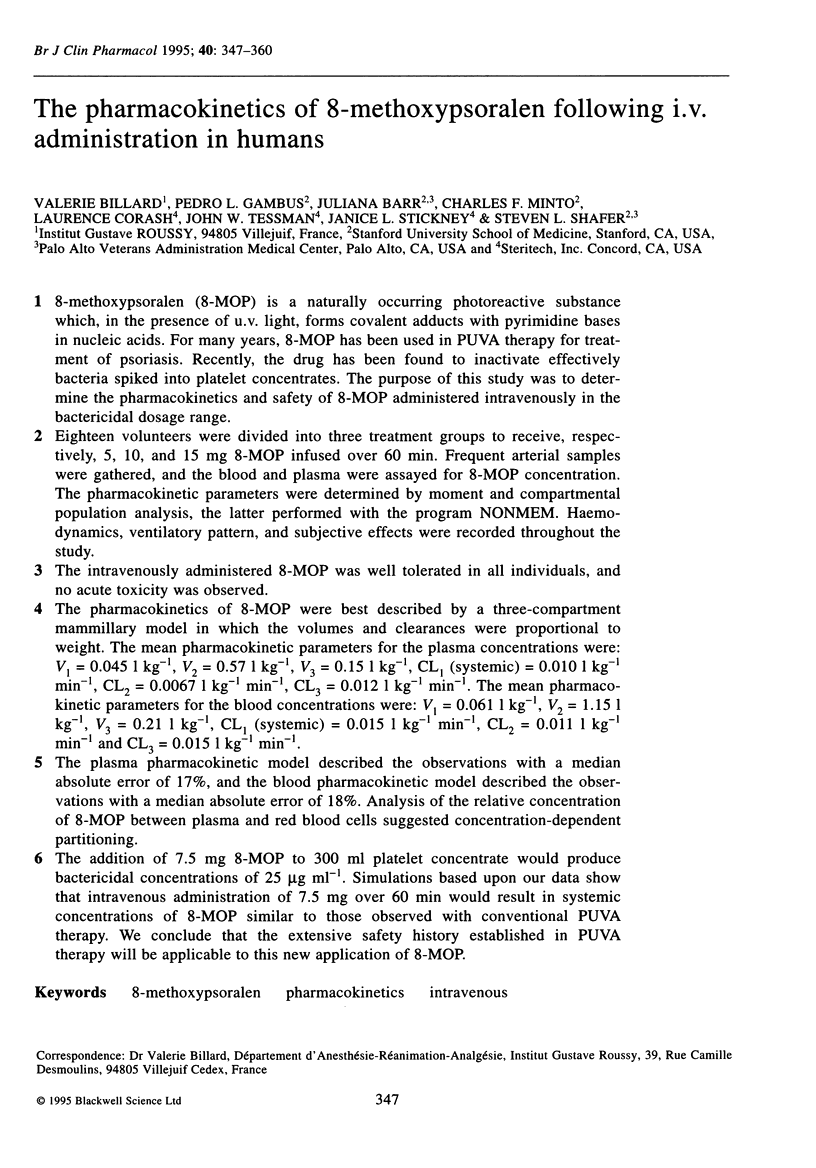
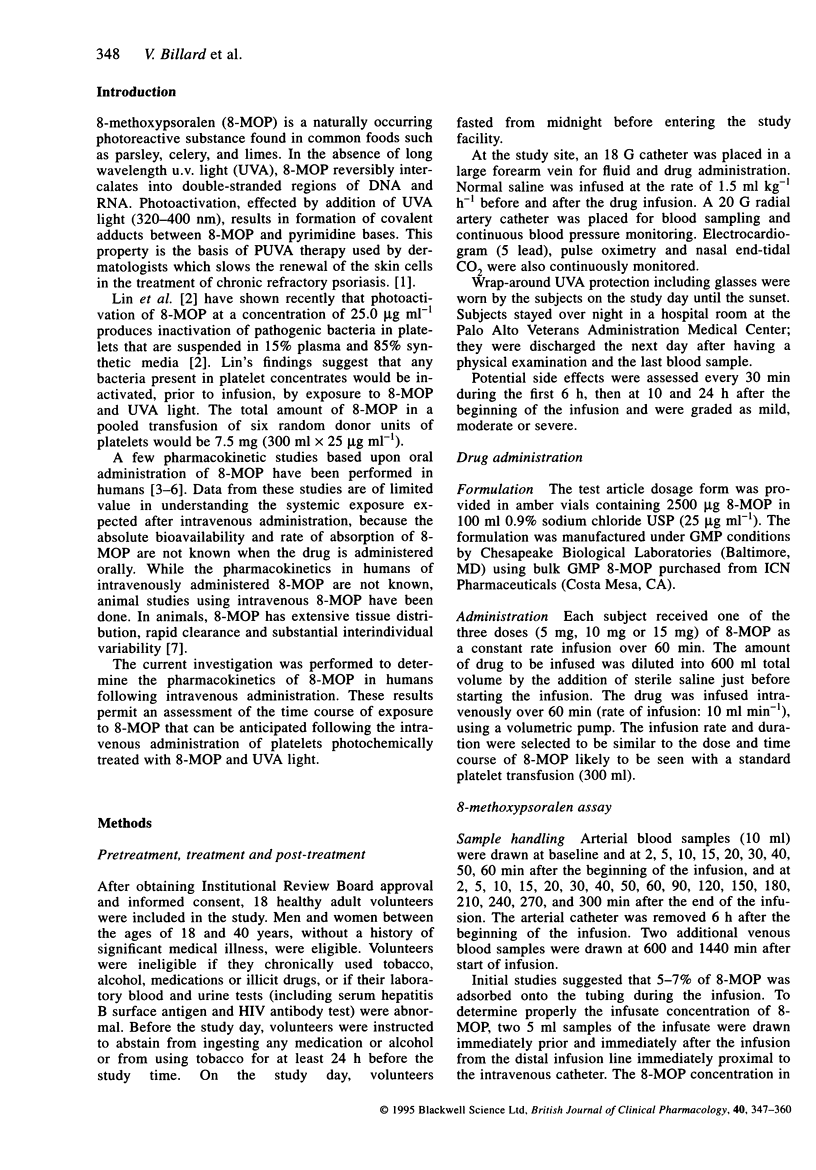
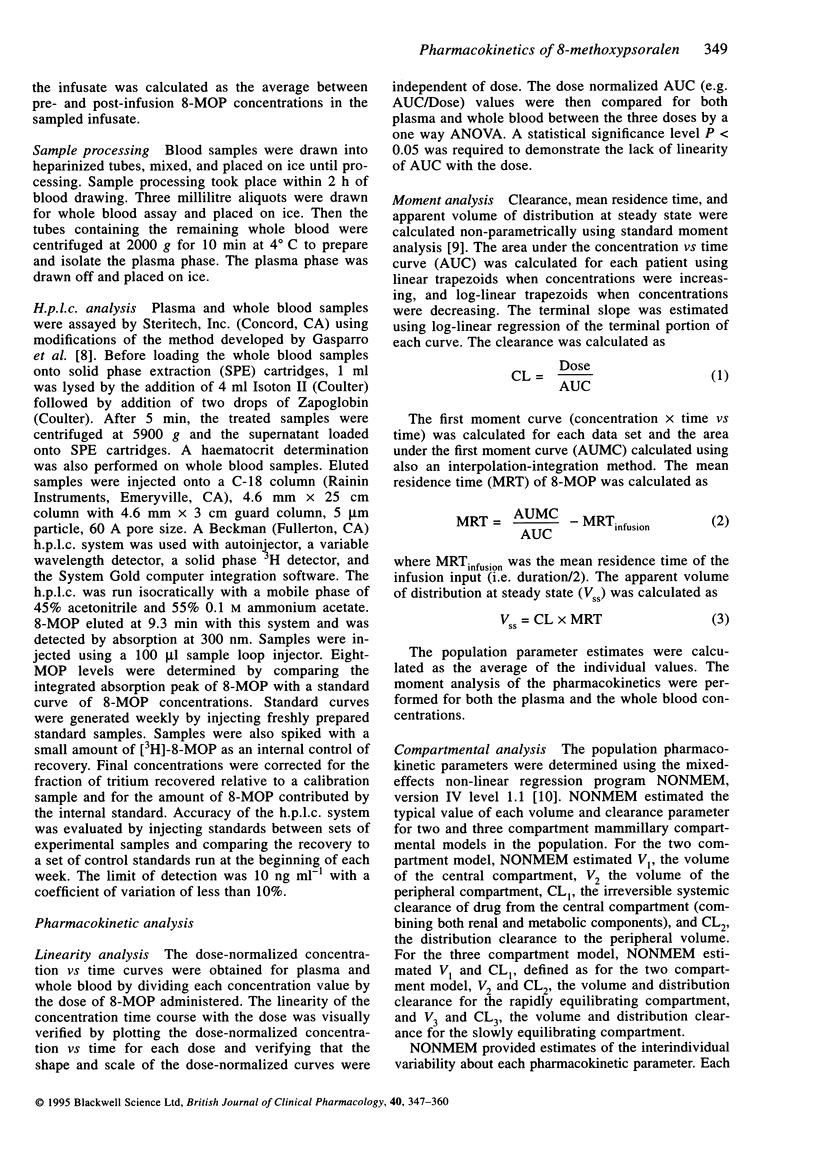
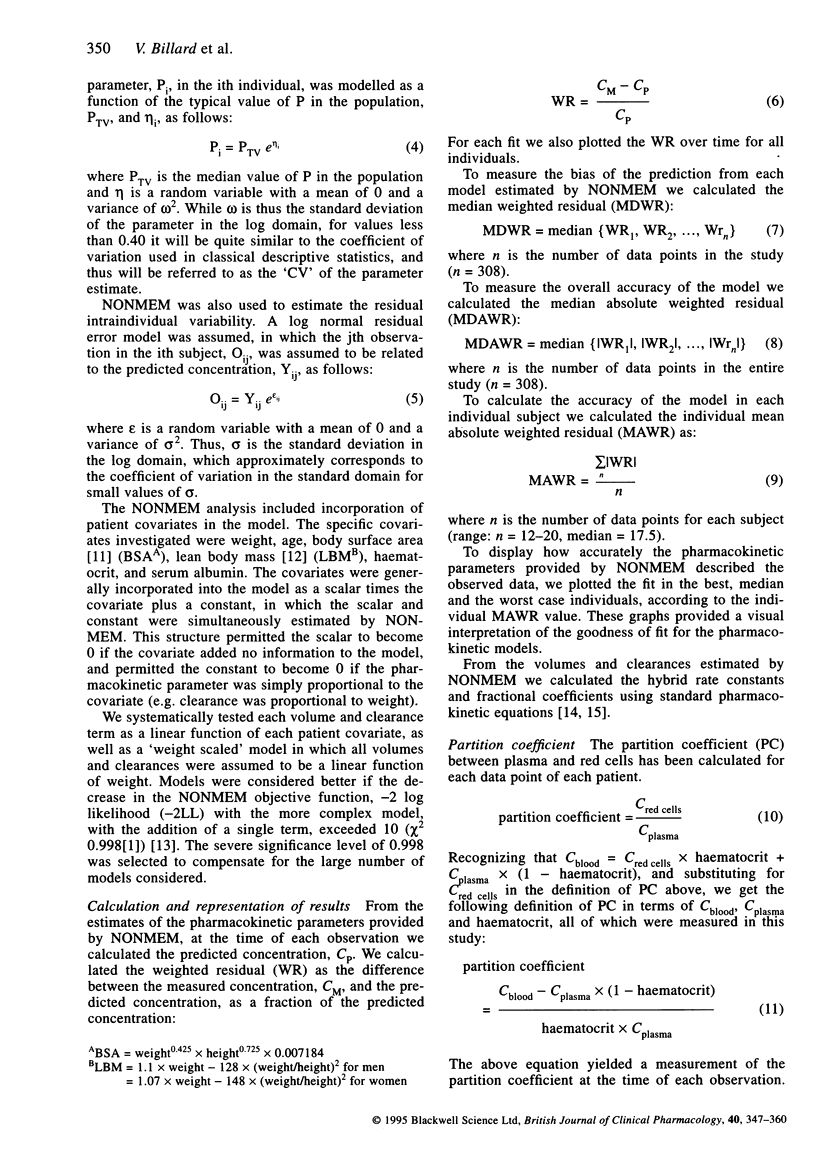
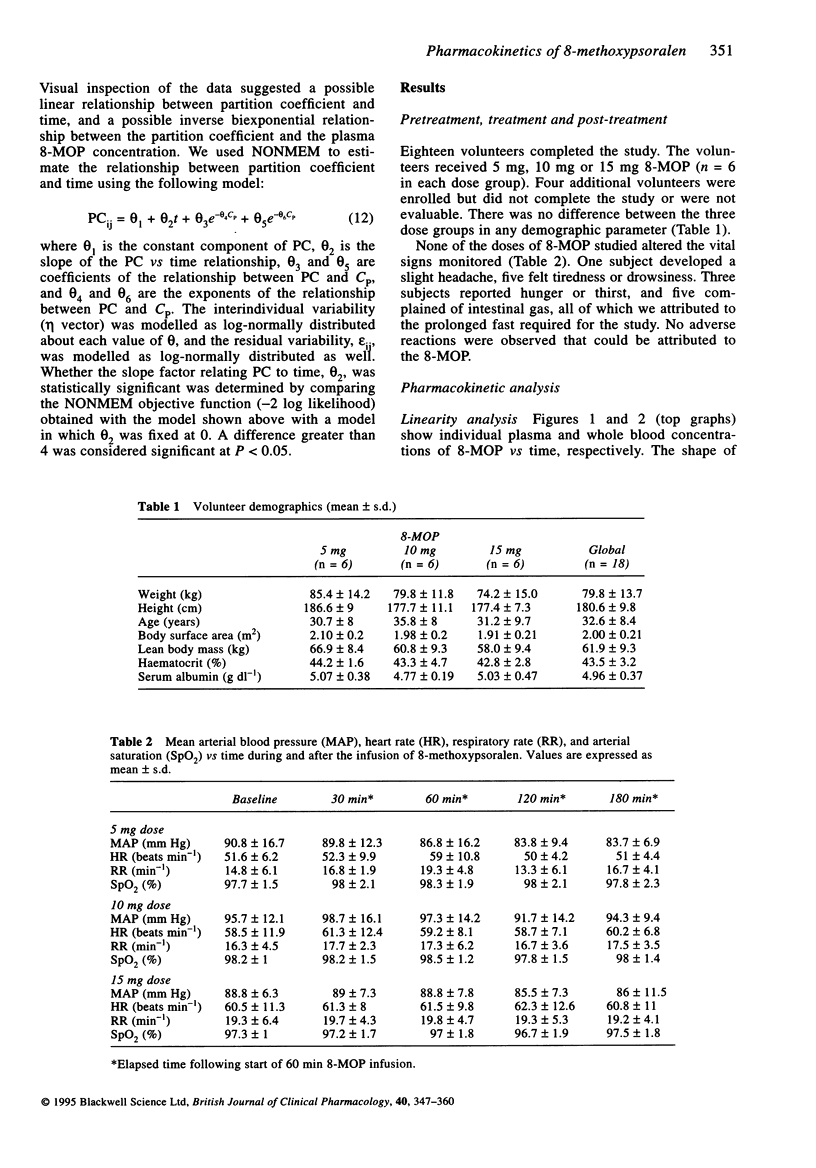
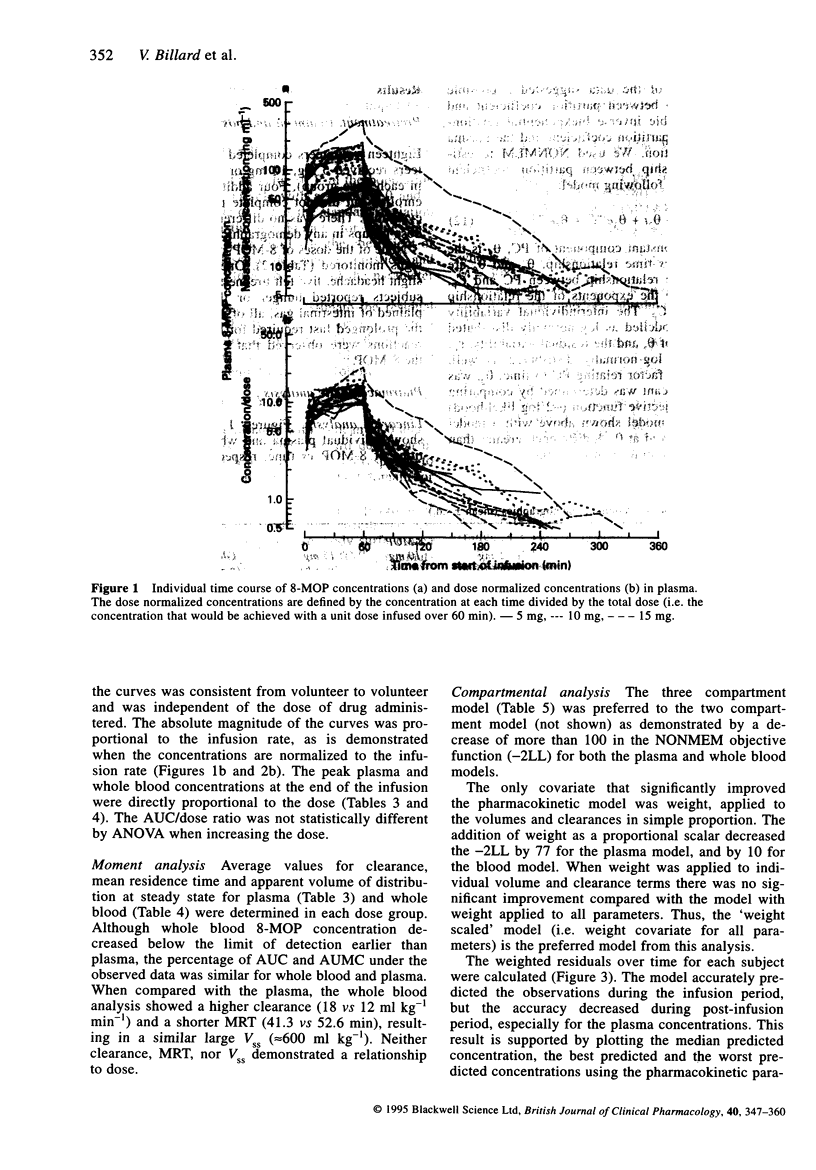
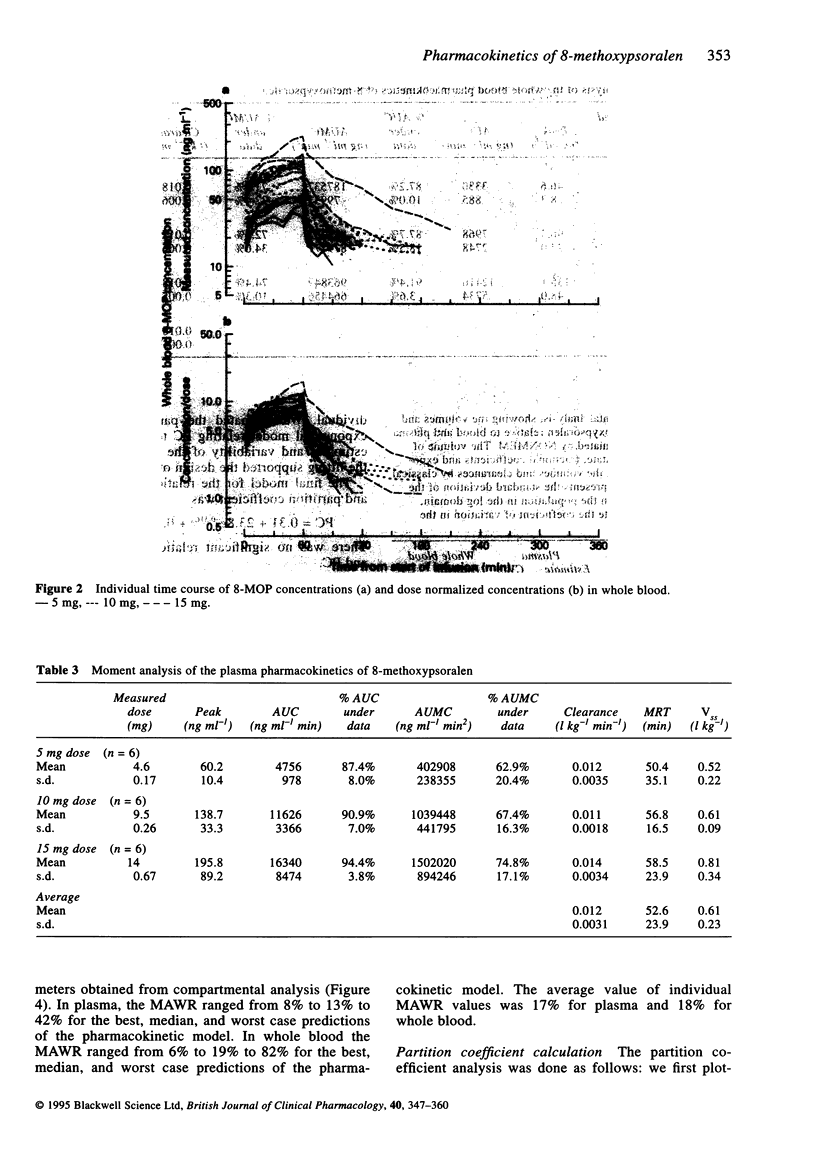
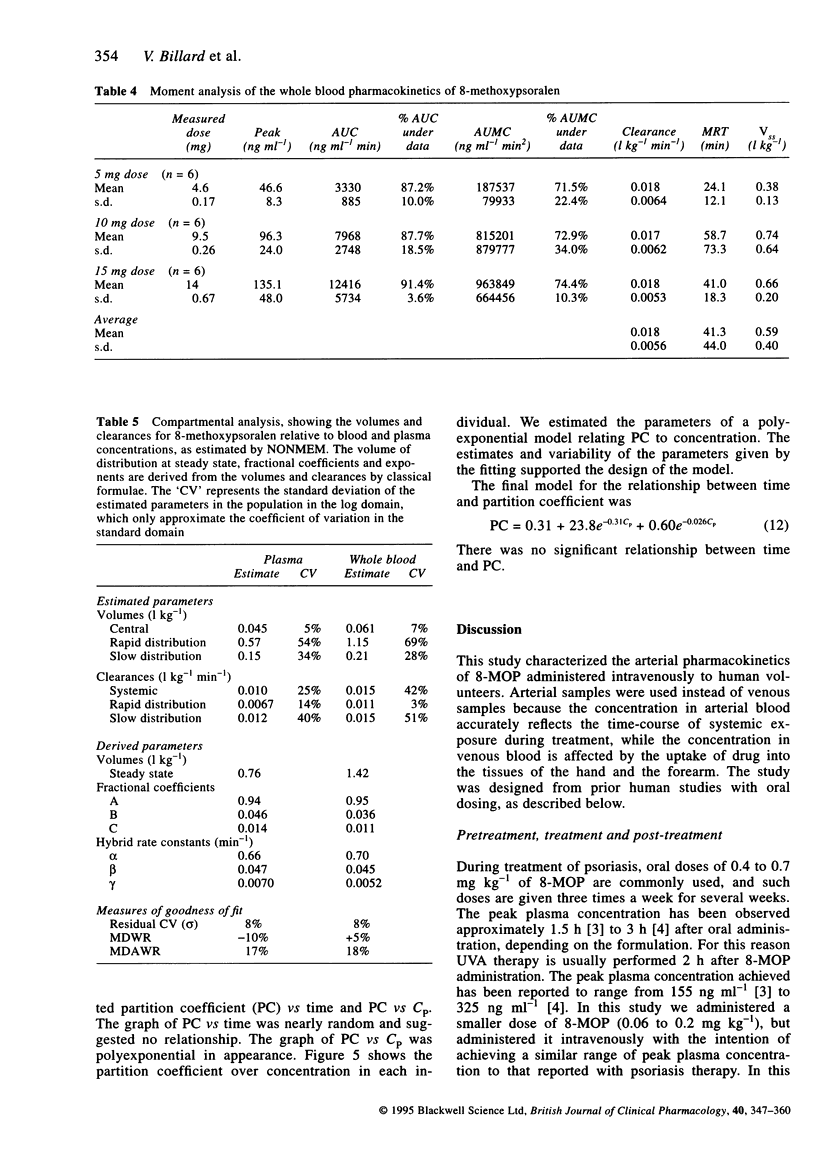
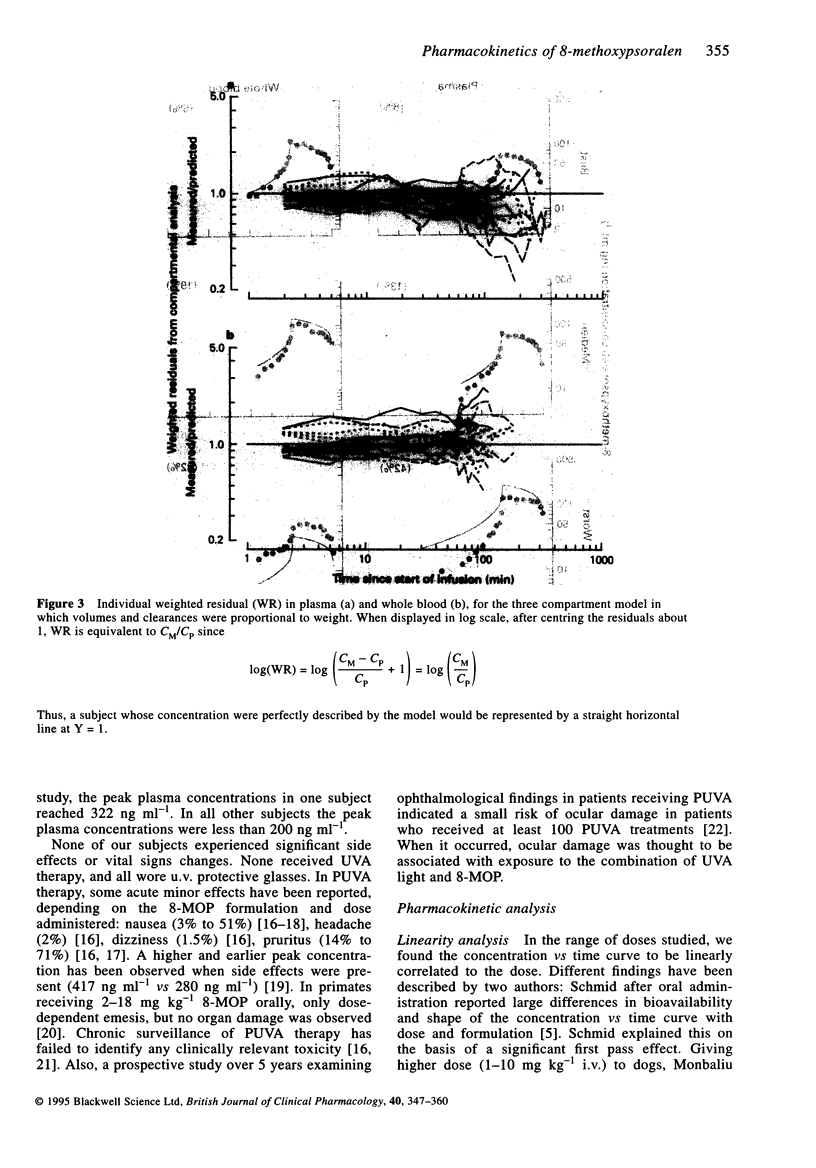
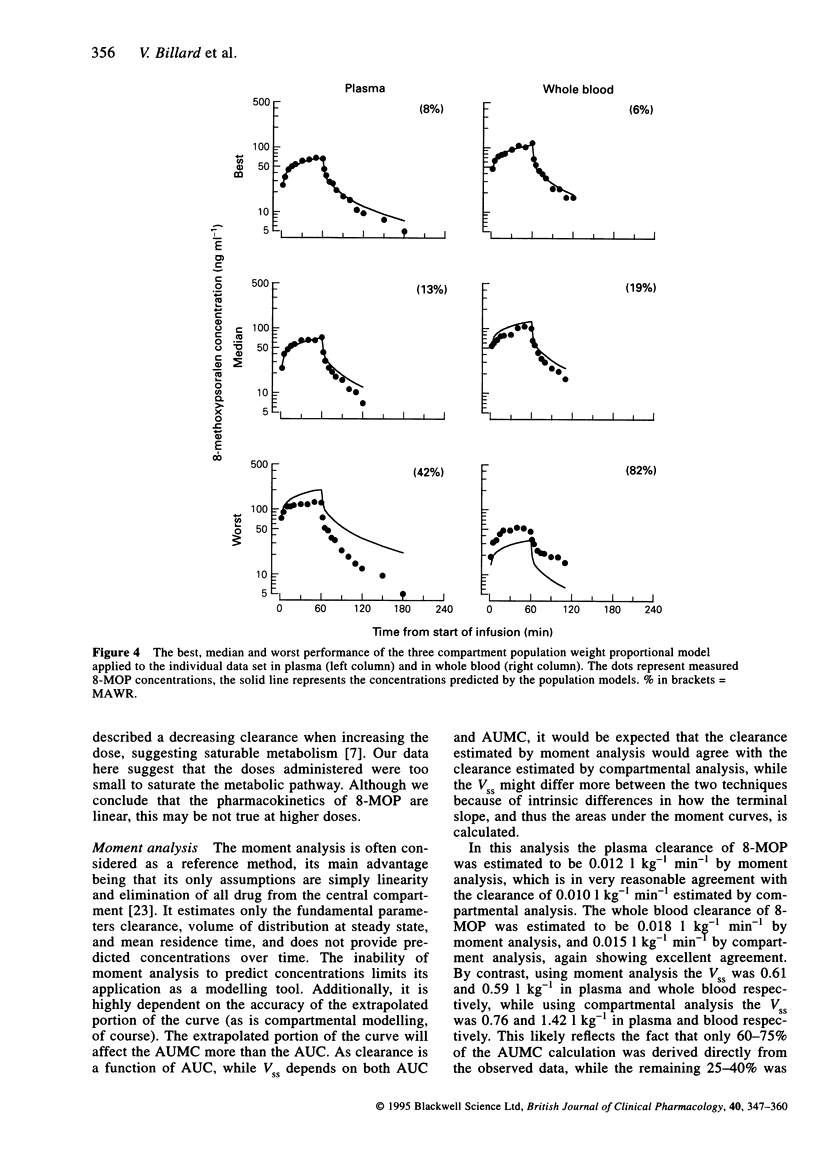

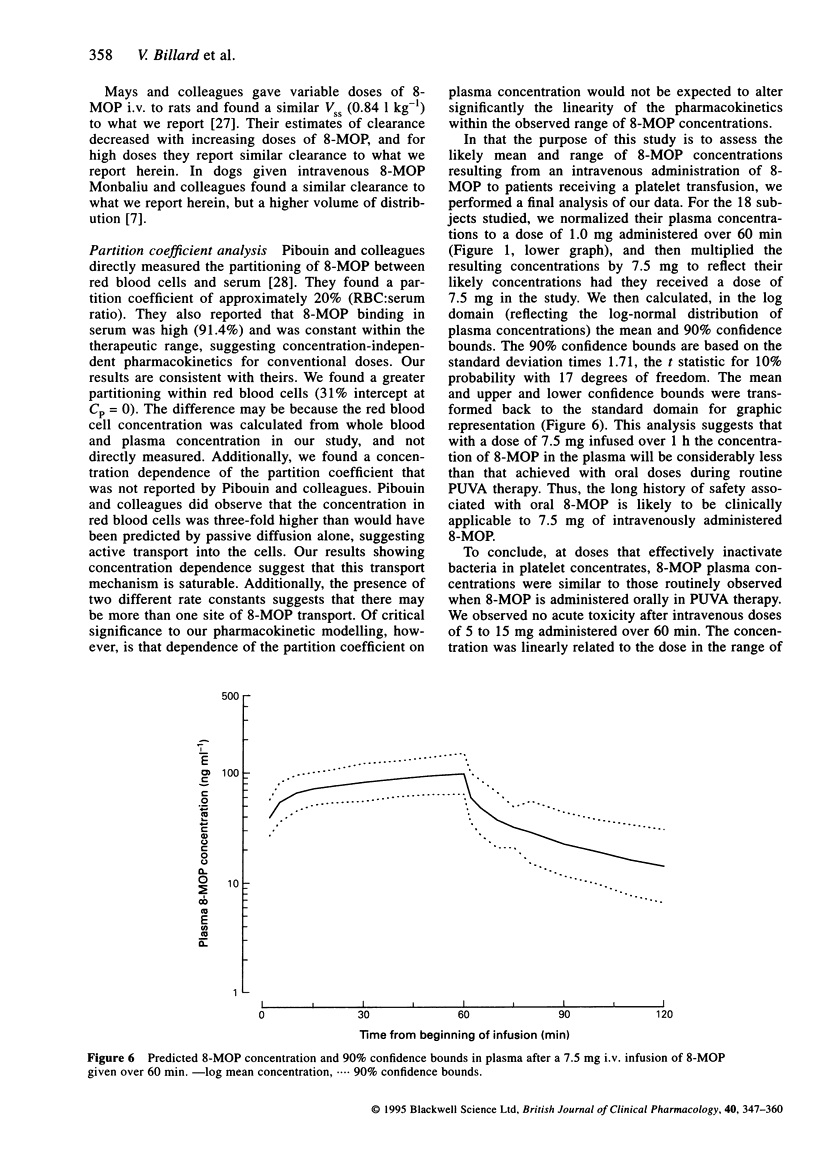
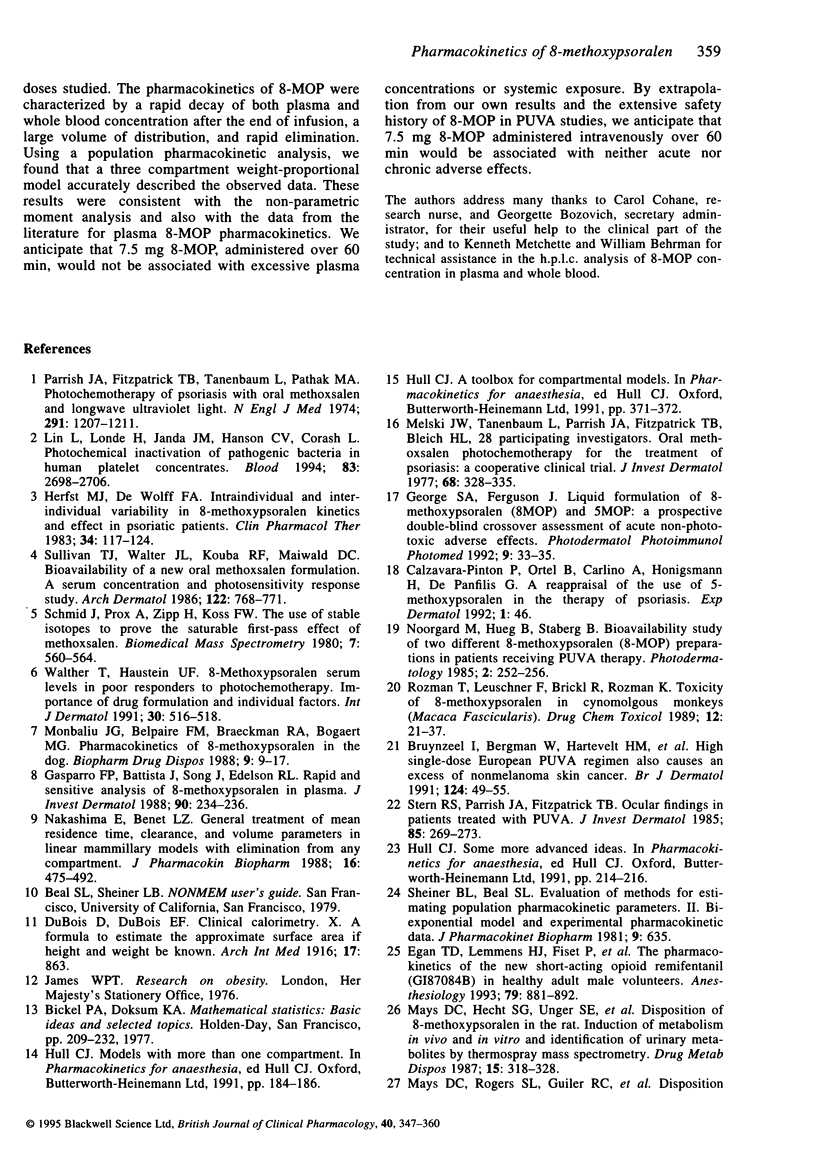

Selected References
These references are in PubMed. This may not be the complete list of references from this article.
- Bruynzeel I., Bergman W., Hartevelt H. M., Kenter C. C., Van de Velde E. A., Schothorst A. A., Suurmond D. 'High single-dose' European PUVA regimen also causes an excess of non-melanoma skin cancer. Br J Dermatol. 1991 Jan;124(1):49–55. doi: 10.1111/j.1365-2133.1991.tb03281.x. [DOI] [PubMed] [Google Scholar]
- Calzavara-Pinton P., Ortel B., Carlino A., Honigsmann H., De Panfilis G. A reappraisal of the use of 5-methoxypsoralen in the therapy of psoriasis. Exp Dermatol. 1992 Jul;1(1):46–51. doi: 10.1111/j.1600-0625.1992.tb00071.x. [DOI] [PubMed] [Google Scholar]
- Egan T. D., Lemmens H. J., Fiset P., Hermann D. J., Muir K. T., Stanski D. R., Shafer S. L. The pharmacokinetics of the new short-acting opioid remifentanil (GI87084B) in healthy adult male volunteers. Anesthesiology. 1993 Nov;79(5):881–892. doi: 10.1097/00000542-199311000-00004. [DOI] [PubMed] [Google Scholar]
- Gasparro F. P., Battista J., Song J., Edelson R. L. Rapid and sensitive analysis of 8-methoxypsoralen in plasma. J Invest Dermatol. 1988 Feb;90(2):234–236. doi: 10.1111/1523-1747.ep12462304. [DOI] [PubMed] [Google Scholar]
- George S. A., Ferguson J. Liquid formulations of 8-methoxypsoralen (8-MOP) and 5-MOP: a prospective double-blind crossover assessment of acute non-phototoxic adverse effects. Photodermatol Photoimmunol Photomed. 1992 Feb;9(1):33–35. [PubMed] [Google Scholar]
- Herfst M. J., De Wolff F. A. Intraindividual and interindividual variability in 8-methoxypsoralen kinetics and effect in psoriatic patients. Clin Pharmacol Ther. 1983 Jul;34(1):117–124. doi: 10.1038/clpt.1983.139. [DOI] [PubMed] [Google Scholar]
- Lin L., Londe H., Janda J. M., Hanson C. V., Corash L. Photochemical inactivation of pathogenic bacteria in human platelet concentrates. Blood. 1994 May 1;83(9):2698–2706. [PubMed] [Google Scholar]
- Mays D. C., Hecht S. G., Unger S. E., Pacula C. M., Climie J. M., Sharp D. E., Gerber N. Disposition of 8-methoxypsoralen in the rat. Induction of metabolism in vivo and in vitro and identification of urinary metabolites by thermospray mass spectrometry. Drug Metab Dispos. 1987 May-Jun;15(3):318–328. [PubMed] [Google Scholar]
- Melski J. W., Tanenbaum L., Parrish J. A., Fitzpatrick T. B., Bleich H. L. Oral methoxsalen photochemotherapy for the treatment of psoriasis: a cooperative clinical trial. J Invest Dermatol. 1977 Jun;68(6):328–335. doi: 10.1111/1523-1747.ep12496022. [DOI] [PubMed] [Google Scholar]
- Monbaliu J. G., Belpaire F. M., Braeckman R. A., Bogaert M. G. Pharmacokinetics of 8-methoxypsoralen in the dog. Biopharm Drug Dispos. 1988 Jan-Feb;9(1):9–17. doi: 10.1002/bod.2510090103. [DOI] [PubMed] [Google Scholar]
- Nakashima E., Benet L. Z. General treatment of mean residence time, clearance, and volume parameters in linear mammillary models with elimination from any compartment. J Pharmacokinet Biopharm. 1988 Oct;16(5):475–492. doi: 10.1007/BF01062381. [DOI] [PubMed] [Google Scholar]
- Nørgaard M., Hueg B., Staberg B. Bioavailability study of two different 8-methoxypsoralen (8-MOP) preparations in patients receiving PUVA therapy. Photodermatol. 1985 Aug;2(4):252–256. [PubMed] [Google Scholar]
- Parrish J. A., Fitzpatrick T. B., Tanenbaum L., Pathak M. A. Photochemotherapy of psoriasis with oral methoxsalen and longwave ultraviolet light. N Engl J Med. 1974 Dec 5;291(23):1207–1211. doi: 10.1056/NEJM197412052912301. [DOI] [PubMed] [Google Scholar]
- Pibouin M., Zini R., Nguyen P., Renouard A., Tillement J. P. Binding of 8-methoxypsoralen to human serum proteins and red blood cells. Br J Dermatol. 1987 Aug;117(2):207–215. doi: 10.1111/j.1365-2133.1987.tb04118.x. [DOI] [PubMed] [Google Scholar]
- Rozman T., Leuschner F., Brickl R., Rozman K. Toxicity of 8-methoxypsoralen in cynomolgous monkeys (Macaca fascicularis). Drug Chem Toxicol. 1989 Mar;12(1):21–37. doi: 10.3109/01480548908999140. [DOI] [PubMed] [Google Scholar]
- Schmid J., Prox A., Zipp H., Koss F. W. The use of stable isotopes to prove the saturable first-pass effect of methoxsalen. Biomed Mass Spectrom. 1980 Nov;7(11-12):560–564. doi: 10.1002/bms.1200071123. [DOI] [PubMed] [Google Scholar]
- Sheiner L. B., Beal S. L. Evaluation of methods for estimating population pharmacokinetic parameters. II. Biexponential model and experimental pharmacokinetic data. J Pharmacokinet Biopharm. 1981 Oct;9(5):635–651. doi: 10.1007/BF01061030. [DOI] [PubMed] [Google Scholar]
- Stern R. S., Parrish J. A., Fitzpatrick T. B. Ocular findings in patients treated with PUVA. J Invest Dermatol. 1985 Sep;85(3):269–273. doi: 10.1111/1523-1747.ep12276752. [DOI] [PubMed] [Google Scholar]
- Sullivan T. J., Walter J. L., Kouba R. F., Maiwald D. C. Bioavailability of a new oral methoxsalen formulation. A serum concentration and photosensitivity response study. Arch Dermatol. 1986 Jul;122(7):768–771. [PubMed] [Google Scholar]
- Walther T., Haustein U. F. 8-Methoxypsoralen serum levels in poor responders to photochemotherapy. Importance of drug formulation and individual factors. Int J Dermatol. 1991 Jul;30(7):516–518. doi: 10.1111/j.1365-4362.1991.tb04877.x. [DOI] [PubMed] [Google Scholar]


